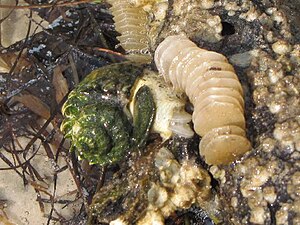Melongenidae
| Melongenidae | ||||||||||||
|---|---|---|---|---|---|---|---|---|---|---|---|---|

Female of Melongena corona lays eggs |
||||||||||||
| Systematics | ||||||||||||
|
||||||||||||
| Scientific name | ||||||||||||
| Melongenidae | ||||||||||||
| Gill , 1871 (1854) |
The Melongenidae , German crown snails and pear snails , are a rather small family of medium-sized to very large marine snails with around 30 species that occur in tropical and temperate seas. The representatives of the family are carnivores and scavengers .
features
The right-hand winding casings of the Melongenidae have a large, egg-shaped casing mouth with a smooth inner lip and an open, wide and short or narrow and long siphon channel. In adult snails, they are 2.5 to 58 cm tall. The whorls are often studded with knots or spikes towards the seam, which then give the bowls the typical crown shape. The periostracum is thick. The thick, horny operculum is claw-shaped with a terminal core.
Unlike the outwardly similarly shaped Fasciolariidae , these snails are not colored red. They have a long, narrow head with moderately short antennae, at the base of which are the eyes, and a very long, extendable proboscis . The foot is big and strong.
The animals are separate sexes with internal fertilization. The eggs are deposited in piles or strings of egg capsules, in which the larval development takes place, so that ready-made snails hatch.
Way of life, occurrence and distribution
The Melongenidae are common in tropical and temperate seas. They mostly live in shallow sea water on sand and mud. The species of the Melongenidae are mainly scavengers , sometimes carnivores , which feed on large mussels .
The Melongenidae include the American crown snail ( Melongena corona ) living in the West Atlantic , the West Indian crown ( Melongena melongena ) of the Caribbean, the Pacific crown snail ( Melongena patula ) that occurs on the Pacific coast of America and the Indo-Pacific as well as the species Pugilina cochlidium Representatives of the genus Volema called pear snails , including Volema paradisiaca in the Indian Ocean and Volema myristica around the Philippines and Indonesia.
Systematics
According to Bouchet and Rocroi (2005), the Melongenidae family is one of six families in the superfamily Buccinoidea . They divide the Melongenidae family into two subfamilies:
- Melongeninae Gill, 1871 (1854) - Synonyms: Cassidulidae Gray, 1854 (invalid); Galeodidae Thiele, 1925 (invalid); Volemidae Winckworth, 1945; Heligmotomidae Adegoke, 1977
- Echinofulgurinae Petuch, 1994
In the past, the genera Busycon and Busycotype were also counted among the Melongenidae. On the basis of anatomical investigations of the digestive system and a cladistic analysis on a molecular genetic basis by Kosyan and Kantor (2004), these two genera were placed in the Buccinidae family .
literature
- John W. Tunnell, Jean Andrews, Noe C Barrera, Fabio Moretzsohn: Encyclopedia of Texas Seashells: Identification, Ecology, Distribution, and History . Texas A&M University Press, College Station (Texas) 2010. 512 pp. Melongenidae : p. 222.
- Philippe Bouchet & Jean-Pierre Rocroi: Part 2. Working classification of the Gastropoda . Malacologia, 47: 239-283, Ann Arbor 2005 ISSN 0076-2997
- Winston Ponder & David Lindberg, Towards a phylogeny of gastropod molluscs; an analysis using morphological characters . Zoological Journal of the Linnean Society, 119: 83-265, London 1997 ISSN 0024-4082
- Frank Riedel: Origin and evolution of the "higher" Caenogastropoda . Berliner Geoscientific Abhandlungen, Series E, Volume 32, Berlin 2000, 240 pages, ISBN 3-89582-077-6 .
Web links
- Fischhaus Zepkow: Family Melongenidae - crown snails
- Melongenidae . From: JM Poutiers: Gastropods . In: Kent E. Carpenter, Volker H. Niem (eds.): FAO Species identification guide for fishery purposes. The living marine resources of the Western Central Pacific. Volume 1: Seaweeds, corals, bivalves and gastropods. Food and Agriculture Organization of the United Nations, Rome, 1998. pp. 582ff.
- ITIS report
- Animal Diversity Web
- National Center for Biotechnology Information
- Information Center Chemistry Biology Pharmacy of the ETH Zurich: European crown and pear snails
Individual evidence
- ^ AR Kosyan, Yu. I. Kantor (2004): Morphology, taxonomic status and relationships of Melongenidae (Gastropoda: Neogastropoda) (PDF; 191 kB) . Ruthenica 14 (1), pp. 9-36.